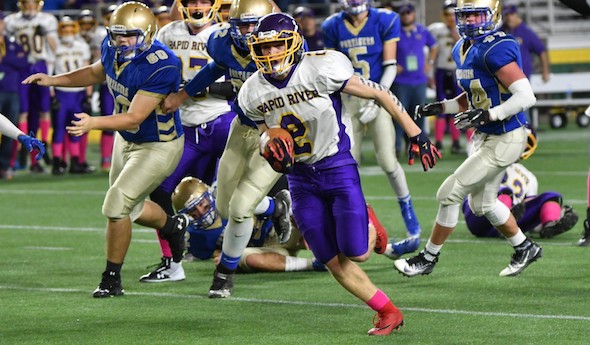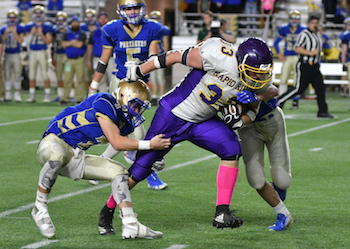
Rapid River Rumbles to History-Making Finish
November 17, 2018
By Geoff Kimmerly
Second Half editor
MARQUETTE – Since the opening kickoff of 8-Player Football Playoffs in 2011, Rapid River has been on the verge of winning its first MHSAA Finals championship in this sport.
In that first year’s title game, also at Northern Michigan University’s Superior Dome, the Rockets fell to Carsonville-Port Sanilac. The next year saw a Semifinal run. And then in 2013 at Greenville’s Legacy Field, another title game defeat, to Peck.
Four seasons of earlier-round playoff losses followed. But all of those are more distant memories after Saturday.
Rapid River hoisted its first championship trophy in football after a 30-18 win over Onekama back at the Superior Dome in the 8-Player Division 2 Final.
“It’s my senior year. Our coach has been here twice, but never won it. To get him one before he would retire … (we) did it for all the people on my team,” Rockets senior Gunner Larson said. “Just an amazing experience. Gotta go for the ride.”
Just a quick note: Rapid River coach Steven Ostrenga didn’t announce his retirement after his 20th season running the program came to a close. But Larson and his teammates know it will happen someday – but now without the “what if” of just missing out on a championship.
Rapid River and Onekama both earned their first trophies of 2018 during the playoffs after both finished third in their respective leagues, Onekama behind two contenders for the Division 1 title and Rapid River behind Division 1 runner-up Pickford and Engadine, which the Rockets then beat in the first round by two points after falling to the Eagles by 18 only two weeks prior.
And Rapid River certainly played like a champion Saturday, relying on its strengths especially up front to outgain Onekama 341-212 in yardage – but more importantly, hold onto the ball for 33½ minutes to the Portagers’ 14:30.
The Rockets ran 66 times for 305 yards as a team, with junior Tyler Sundling gaining 123 and scoring two touchdowns and Larson running for 107 and a score. Senior quarterback Brent Lundquist tossed a 14-yard touchdown pass to senior Nate Olson during a change of pace.
Rapid River carried a 22-8 lead into the fourth quarter and held on despite two Onekama scores over the final 12 minutes.
“We’ve never given up that many yards rushing and that many points,” said Onekama coach John Neph, whose defense was allowing only 8.1 points per game entering the day. “So I think that speaks to the quality of the Rapid River offensive line and their backs. They’re flying around and doing some good things defensively, and that was a huge difference.
“We never thought we were out of the game till maybe the last touchdown there that the Rockets had. We hung in and hung in, and the offense kinda left the defense out there way too long. (And) the conversions they could get on third and fourth down were just critical to keep the drives going.”
 Rapid River didn’t have a turnover and only six penalties. Onekama had five penalties but also lost two fumbles. And those Rockets conversions clearly were difference makers; Rapid River was 10 of 17 on third down and 4 of 6 on fourth, while Onekama was 4 of 10 on third downs and didn’t have a fourth down try.
Rapid River didn’t have a turnover and only six penalties. Onekama had five penalties but also lost two fumbles. And those Rockets conversions clearly were difference makers; Rapid River was 10 of 17 on third down and 4 of 6 on fourth, while Onekama was 4 of 10 on third downs and didn’t have a fourth down try.
“Every team that we have is unique. We had a lot of good football teams; other teams were just a little bit better than us in those games,” Ostrenga said of past playoff trips. “We made some mistakes today, but we were almost mistake-free. And that’s the key.”
He threw plenty of credit to his assistants for getting the team ready, to his linemen for their work up front, and to a host of other coaches – including one in basketball – who had influenced and taught him some things over the years. Ostrenga also has led his share of champions, including eight Upper Peninsula Finals winners in boys track & field.
And at the same time Saturday, it felt like Onekama could be following a similar path and only a few steps behind.
This championship game was the first in football for the Portagers, who are 19-5 over two seasons in 8-player after making the playoffs their last three seasons with 11 on the field.
Onekama will graduate some key contributors including running back/linebacker Ben Acton, who ran for 78 yards and a touchdown and also had a team-high 16 tackles including three for losses.
But the Portagers should also bring back 14 of 19 players next fall, including junior quarterback Luke Mauntler (188 yards, two touchdown passes Saturday) and junior tight end Wade Sedlar, who with senior tight end Rylan Clarke caught those scoring tosses.
Juniors Matthew Mallison and Taylor Bennett followed Acton with 15 and 13 tackles, respectively.
“We have five seniors, but we do have 11 juniors coming back,” Neph said. “So we’re hoping we can replicate this. It’s absolutely tasking on a team to repeat and get this far. There’s some outstanding teams we were able to overcome to get this far. We’d love to come here again, but it’s going to be a ton of hard work and effort moving forward.
“But again, this is an historic season for our program. The guys going to the state finals was just a dream come true for all of us.”
PHOTOS: (Top) Rapid River's Tyler Sundling (2) breaks several tackles and scores a touchdown Saturday. (Middle) Rapid River's Gunner Larson (33) is taken down by Onekama's Luke Mauntler (7) and Ben Johnson (12). (Photos by Cara Kamps.)

NFHS Voice: Campaign Touts Benefits of High School Football
By
Karissa Niehoff
NFHS Executive Director
May 21, 2021
A full return to high school sports and performing arts programs – that’s the hope for this fall in schools across the country.
After a year of unprecedented challenges in keeping these programs going due to the pandemic, which included 11 states that conducted their primary football season this spring, there is great optimism as we look to a new school year.
Even in those states that were able to conduct activities last fall, attendance restrictions kept many fans out of stadiums and watching games online. However, with vaccine eligibility now at 12 years of age and older and with vaccinations continuing during the next three months, the likelihood of routines and traditions returning this fall grows stronger each day.
And there is no tradition more anticipated than the full-scale return of high school football. While there were 34 states there were fortunate enough to conduct football at some level last fall, the routines were anything but normal.
This fall, however, we anticipate a return to the energy and excitement of the 2019 season when 1,003,524 boys participated in 11-player football. That total marked a decline of only 2,489 from the previous year and was a good sign of a renewed confidence on the part of parents and student-athletes that concerns about the risk of injury were being addressed.
While boys participation in 11-player football has exceeded one million participants every year since 1999 and is overwhelmingly the most popular boys sport, there have been concerns about declines in past years.
Last fall, the NFHS and the National Football League announced a partnership to promote the growth, understanding and support for football at the high school level. The NFHS and NFL have been studying participation trends, developing educational tools and striving to restore confidence in students and parents that the sport is, in fact, more focused on risk minimization than ever before.
As a result, the springboard to the return of high school football next fall begins this week with the launch of the #ThisIsHSFootball campaign. Through this effort over the next few months, the NFHS will be reaching out to coaches, students, parents, officials, athletic directors and others with research information, participation trends and data on various risk mitigation efforts that, we believe, continues to make high school football safer than it has ever been.
As a part of this effort, the NFHS produced a video entitled “This is High School Football” designed to detail the benefits of participation in high school football.
As the video states, more so than at any other level of play, parents should feel good about their kids playing high school football.
>Here are some of the many educational and medical safeguards put in place the past 12 years to offer parents a comfort level about the safety standards that are a part of high school football.
► Concussion research and education. All NFHS high school playing rules require a student who is exhibiting signs of a concussion to be removed from the game and not allowed to return until the student has been cleared by a medical professional. Thanks to education and training on the part of students, coaches, trainers, parents and others, research data has shown positive trends in concussion rates. In a recent five-year period, concussion rates during practices dropped from 5.47 to 4.44 concussions per 10,000 athletic exposures.
► Concussion in Sport Course. This free online education course has been available through the NFHS Learning Center since 2010, and millions of individuals have taken the course for a deeper understanding about concussions.
► Concussion Laws. By 2014, every state had adopted state concussion laws that established mandatory protocols, and every state high school association has adopted policies that limit contact during preseason drills and in practices during the season.
► Football equipment. Manufacturers continue to produce higher quality equipment every year, and high school coaches are doing a much better job at teaching and coaching the rules of the game and making attempts to minimize risk of injury for players.
► Emergency Action Plans. Thanks to the NFHS Foundation, a copy of the “Anyone Can Save a Life” emergency action plan originally developed by the Minnesota State High School League was sent to all state high school associations and their high schools, and all schools have access to an AED to help save lives.
► Playing Rules. Risk minimization is a major focus of every NFHS sports rules committee. In football, helmet-to-helmet hits are not allowed.
High school football has been a significant part of schools, towns and communities across America for almost 100 years. The NFHS is committed to making the sport as safe as possible for the millions of kids who will play the sport in the years to come.
Dr. Karissa L. Niehoff is in her third year as executive director of the National Federation of State High School Associations (NFHS) in Indianapolis, Indiana. She is the first female to head the national leadership organization for high school athletics and performing arts activities and the sixth full-time executive director of the NFHS, which celebrated its 100th year of service during the 2018-19 school year. She previously was executive director of the Connecticut Association of Schools-Connecticut Interscholastic Athletic Conference for seven years.

